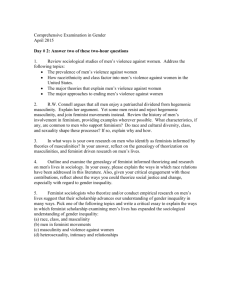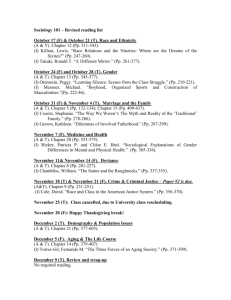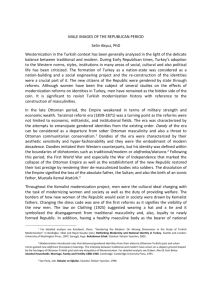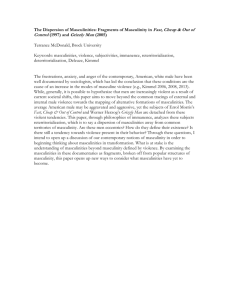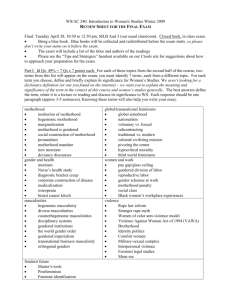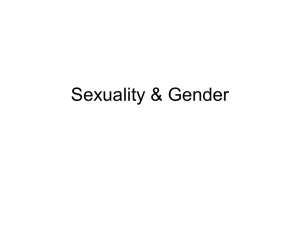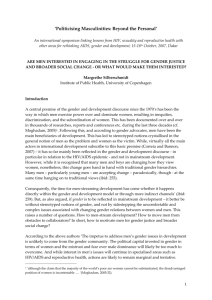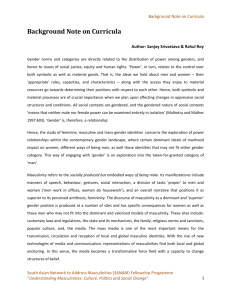Perspectives on Multidimensional Masculinities
advertisement
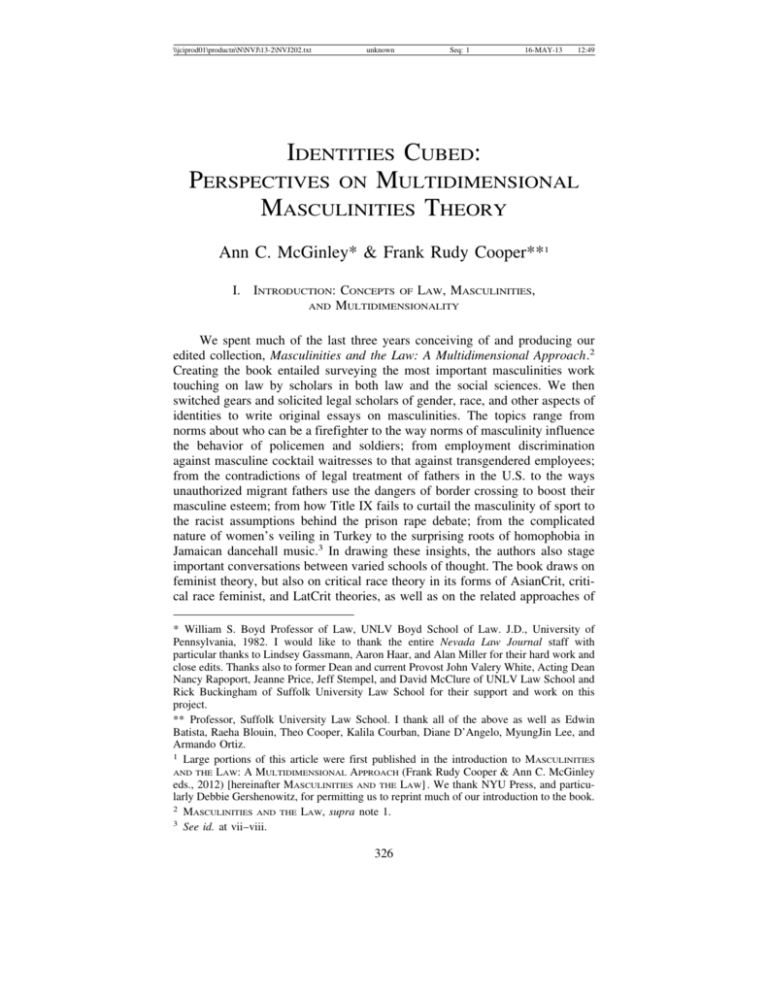
\\jciprod01\productn\N\NVJ\13-2\NVJ202.txt unknown Seq: 1 16-MAY-13 12:49 IDENTITIES CUBED: PERSPECTIVES ON MULTIDIMENSIONAL MASCULINITIES THEORY Ann C. McGinley* & Frank Rudy Cooper**1 I. INTRODUCTION: CONCEPTS OF LAW, MASCULINITIES, AND MULTIDIMENSIONALITY We spent much of the last three years conceiving of and producing our edited collection, Masculinities and the Law: A Multidimensional Approach.2 Creating the book entailed surveying the most important masculinities work touching on law by scholars in both law and the social sciences. We then switched gears and solicited legal scholars of gender, race, and other aspects of identities to write original essays on masculinities. The topics range from norms about who can be a firefighter to the way norms of masculinity influence the behavior of policemen and soldiers; from employment discrimination against masculine cocktail waitresses to that against transgendered employees; from the contradictions of legal treatment of fathers in the U.S. to the ways unauthorized migrant fathers use the dangers of border crossing to boost their masculine esteem; from how Title IX fails to curtail the masculinity of sport to the racist assumptions behind the prison rape debate; from the complicated nature of women’s veiling in Turkey to the surprising roots of homophobia in Jamaican dancehall music.3 In drawing these insights, the authors also stage important conversations between varied schools of thought. The book draws on feminist theory, but also on critical race theory in its forms of AsianCrit, critical race feminist, and LatCrit theories, as well as on the related approaches of * William S. Boyd Professor of Law, UNLV Boyd School of Law. J.D., University of Pennsylvania, 1982. I would like to thank the entire Nevada Law Journal staff with particular thanks to Lindsey Gassmann, Aaron Haar, and Alan Miller for their hard work and close edits. Thanks also to former Dean and current Provost John Valery White, Acting Dean Nancy Rapoport, Jeanne Price, Jeff Stempel, and David McClure of UNLV Law School and Rick Buckingham of Suffolk University Law School for their support and work on this project. ** Professor, Suffolk University Law School. I thank all of the above as well as Edwin Batista, Raeha Blouin, Theo Cooper, Kalila Courban, Diane D’Angelo, MyungJin Lee, and Armando Ortiz. 1 Large portions of this article were first published in the introduction to MASCULINITIES AND THE LAW: A MULTIDIMENSIONAL APPROACH (Frank Rudy Cooper & Ann C. McGinley eds., 2012) [hereinafter MASCULINITIES AND THE LAW] . We thank NYU Press, and particularly Debbie Gershenowitz, for permitting us to reprint much of our introduction to the book. 2 MASCULINITIES AND THE LAW, supra note 1. 3 See id. at vii–viii. 326 \\jciprod01\productn\N\NVJ\13-2\NVJ202.txt Winter 2013] unknown IDENTITIES CUBED Seq: 2 16-MAY-13 12:49 327 ClassCrit and queer theories.4 Both topically and methodologically, therefore, the book is appropriately termed “multidimensional.” What we are trying to accomplish with the book is to introduce a new perspective on identities, law, and culture—Multidimensional Masculinities Theory (“MMT”).5 Following in the wake of critical legal theory, MMT presumes that identities, law, and culture are fundamentally about the distribution of power.6 Law is a particularly potent mechanism for distributing resources because it relies upon assumptions about human behavior that reproduce preexisting social relations. In other words, law and culture are coconstitutive:7 cultural norms influence law and legal norms simultaneously influence culture. Identities, law, and culture are co-constituted in that each influences the others.8 The principal site of analysis for MMT is masculinities. That means we are paying attention to norms—be they hegemonic in general or only in particular contexts—regarding what it means to be manly.9 These norms play out in how individuals see themselves, how they are seen by others, and how they perform their identities in order to influence how they are seen. Norms about masculinities also influence how law is conceived of and enacted in practices. 4 See id. at 2. Of course, forerunners exist. See, e.g., BLACK MEN ON RACE, GENDER, AND SEXUALITY 10 (Devon W. Carbado ed., 1999); Angela P. Harris, Gender, Violence, Race, and Criminal Justice, 52 STAN. L. REV. 777, 782–83 (2000); Darren Lenard Hutchinson, “Gay Rights” for “Gay Whites”?: Race, Sexual Identity, and Equal Protection Discourse, 85 CORNELL L. REV. 1358, 1364 (2000); Francisco Valdes, Beyond Sexual Orientation in Queer Legal Theory: Majoritarianism, Multidimensionality, and Responsibility in Social Justice Scholarship; or, Legal Scholars as Cultural Warriors, 75 DENV. U. L. REV. 1409, 1414–15 (1998). 6 See Kimberlé Crenshaw et al., Introduction to CRITICAL RACE THEORY: THE KEY WRITINGS THAT FORMED THE MOVEMENT xiii (Kimberlé Crenshaw et al. eds., 1995) (introducing book by tracing its roots in Critical Legal Studies concepts such as the critique of law as surreptitiously exercising power) [hereinafter Crenshaw et al., CRITICAL RACE THEORY] . 7 See Julie A. Nice, Equal Protection’s Antinomies and the Promise of a Co-Constitutive Approach, 85 CORNELL L. REV. 1392, 1418 (2000). 8 See Frank Rudy Cooper, The “Seesaw Effect” from Racial Profiling to Depolicing: Toward a Critical Cultural Theory, in THE NEW CIVIL RIGHTS RESEARCH: A CONSTITUTIVE APPROACH 139, 140 (Benjamin Fleury-Steiner & Laura Beth Nielsen eds., 2006) [hereinafter Cooper, The “Seesaw Effect” from Racial Profiling to Depolicing]. 9 Masculinities theory has already established itself in the social sciences, see R. W. CONNELL, MASCULINITIES xi (2d ed. 2005), and posits that “assumptions about the meaning of manhood influence behaviors, ideologies, and institutions.” Frank Rudy Cooper, Our First Unisex President?: Black Masculinity and Obama’s Feminine Side, 86 DENV. U. L. REV. 633, 635 (2009) [hereinafter Cooper, Our First Unisex President?]. Masculinities scholars analyze “how societal norms shape behavior of individual men and women, how masculinities are imbedded in the structure of institutions, and how individuals and groups perform masculinities within those institutions.” Ann C. McGinley, Erasing Boundaries: Masculinities, Sexual Minorities, and Employment Discrimination, 43 U. MICH. J.L. REFORM 713, 720 (2010). The allocation of power based on concepts of masculinity often occurs in an invisible way because masculinity is considered a natural trait deriving from the male biology rather than learned behavior. Masculinities scholars challenge the assumption that masculinities are biological and conclude that masculinities are performances constructed by social norms. Note as well that the term “masculinities” is plural. That is because men (and, sometimes women) perform different types of masculinities ranging from the hegemonic to alternative types of masculinities. See Michael Kimmel, Integrating Men into the Curriculum, 4 DUKE J. GENDER L. & POL’Y 181, 189 (1997). 5 \\jciprod01\productn\N\NVJ\13-2\NVJ202.txt 328 unknown Seq: 3 NEVADA LAW JOURNAL 16-MAY-13 12:49 [Vol. 13:326 Finally, those norms inform cultural assumptions that influence identity formation and law. We thus see masculinities at work in behaviors, institutional structures, and discourses about how the world does or ought to work (ideologies).10 The point of MMT is to look at matters in a multidimensional way. That means considering masculinities to be multifaceted and in perpetual motion. The concept of multidimensionality is invoked by the cover of the book. Drawn in pencil, the Rubik’s Cube has a somewhat provisional look. With its different colored squares mixed up, it suggests a clash among different elements. That dynamism is heightened because the cube is tilted, suggesting that the whole unit, not just its parts, is in motion. This Rubik’s Cube metaphor demonstrates the two basic principles of multidimensionality theory. First, identities are co-constituted. If the red 10 See generally MASCULINITIES AND THE LAW, supra note 1. \\jciprod01\productn\N\NVJ\13-2\NVJ202.txt Winter 2013] unknown Seq: 4 16-MAY-13 IDENTITIES CUBED 12:49 329 squares are thought to represent the individual’s race, we must always bear in mind that the individual also has gender, class, and sex orientation identities, among others. When we move a red square to the front of the cube (if any side can be said to be the front), we also move the green, brown, orange, and other colored cubes into new positions. Metaphorically and in real life, race is linked to gender, class, sex orientation, and other identities. The impression that a red square makes on you is affected by what other squares are around it. Likewise, race does not have one meaning, but its very meaning is influenced by the other identities that are in play. Think about it this way: Doesn’t it matter whether you are black and male or black and female? The precise combination of one’s identities is what both gives the individual her sense of self-identity and influences exactly how others see that individual. Moreover, though, the Rubik’s Cube metaphor also demonstrates multidimensionality theory’s second basic principle, that context is crucial to the formation and interpretation of identities. The Rubik’s Cube may be turned to present just one side or a few sides to the viewer. It may be mostly red, brown, and orange when it is presented that way. Think of the perspective the viewer of the cube is presented with as akin to an individual changing how she presents herself in different contexts. When interacting in an art gallery, an individual may choose to present her creative side; when in a business meeting, she will present her more formal side. Like the Rubik’s Cube, when an individual moves into different contexts, she will reveal different facets of herself. In this sense, the individual elements of the Rubik’s Cube and of our identities are both intertwined and context-dependent. Our book seeks to expand critical legal theory by considering a set of cultural and legal norms—masculinities—that have been under-explored, and to do so in a multidimensional way. It is our premise that masculinities studies offer insights that, especially when using a multidimensional lens, will aid in improved legal interpretation. This essay explains the origins and premises of masculinities theory, the underlying concepts of multidimensionality, and how the two sets of theories can work together to analyze and criticize legal decision-making. Our ultimate goal is to urge lawmakers and judges to adopt new perspectives on issues of human behavior in order to improve law and legal interpretation. II. HISTORICAL DEVELOPMENT OF UNDERLYING THEORIES Multidimensional masculinities theory is both substantive and methodological. As substance, it encourages the law to take into account the power of cultural norms by considering how a person’s overlapping identities affect how he or she is perceived and how he or she will react in different contexts. MMT is a perspective that investigates how concepts of masculinity interact with other categories of identity in varied legal contexts. Multidimensionality theory holds that categories of identity are (1) always intertwined with one another and (2) experienced and interpreted differently in different contexts.11 We apply 11 See Frank Rudy Cooper, Masculinities, Post-Racialism and the Gates Controversy: The False Equivalence Between Officer and Civilian, 11 NEV. L.J. 1, 3 (2010). \\jciprod01\productn\N\NVJ\13-2\NVJ202.txt 330 unknown Seq: 5 NEVADA LAW JOURNAL 16-MAY-13 12:49 [Vol. 13:326 multidimensionality theory to masculinities research because it helps to show that masculinities differ depending on the context and the other categories of identity with which they overlap. We bring masculinities research to multidimensionality theory because too few scholars have focused multidimensionality theory on the often-invisible category of masculinity. As methodology, MMT encourages us to shift the lens so that we can view legal doctrine through different prisms that illuminate human behavior and how the law should relate to it. A short way of explaining the methodology is provided by Nancy Dowd, Nancy Levit, and Ann McGinley in Feminist Legal Theory Meets Masculinities Theory, a chapter in our book. They say that we should constantly shift lenses to take different perspectives on issues.12 For example, a study of boys in prisons requires us to shift the primary lens of analysis from gender to race in order to understand the ways racism constructs boys of color as inherently dangerous.13 The shifting of lenses we advocate is another metaphor for the shifting perspectives on identities that the cover of the book suggests. Multidimensional masculinities theory has a number of theoretical foundations. It derives from feminist theory, feminist legal theory, and critical race theory (especially critical race feminism, as influenced by queer theory), which together spawned multidimensionality theory. We encourage the expansion of masculinities research by viewing concepts of masculinity through a multidimensional lens in order to examine legal issues in new ways. To explain our proposed approach, we begin with a short explanation of how MMT has emerged and where we hope the new discipline of MMT will go. A. Feminist Theory and Feminist Legal Theory Masculinities theory is an outgrowth of the feminist theorizing that developed during the feminist movement of the late 1960s and early 1970s.14 These feminists posited that patriarchal systems allowed men as a group to exercise power over women as a group.15 Soon thereafter, feminist legal theory developed. Feminist legal theory “as an approach . . . describes and analyzes the law’s impact on women, particularly focusing on how law subordinates women.”16 As the numbers of women in the legal academy grew, they began to challenge the male-oriented foundations of the law using the new tool of feminist legal theory.17 Similarly, the number of law professors of color increased significantly in the late 1980s, and some of these professors began to write about race in new 12 See Nancy E. Dowd, Nancy Levit & Ann C. McGinley, Feminist Legal Theory Meets Masculinities Theory, in MASCULINITIES AND THE LAW, supra note 1, at 25, 46 [hereinafter Dowd, Levit & McGinley, Feminist Legal Theory]. 13 See id. at 31; see also Part III.B. infra. 14 ÀNGELS CARABÍ, CONSTRUCTING NEW MASCULINITIES: THE REPRESENTATION OF MASCULINITY IN U.S. LITERATURE AND CINEMA (1980–2003) 4 (Ministerio de Trabajo y Asuntos Sociales, Instituto de la Mujer 2003) (Spain). 15 Id. at 10. 16 Twila L. Perry, Family Law, Feminist Legal Theory, and the Problem of Racial Hierarchy, in TRANSCENDING THE BOUNDARIES OF LAW: GENERATIONS OF FEMINISM AND LEGAL THEORY 243, 244 (Martha Albertson Fineman ed., 2011). 17 Id. at 243–44. \\jciprod01\productn\N\NVJ\13-2\NVJ202.txt Winter 2013] unknown IDENTITIES CUBED Seq: 6 16-MAY-13 12:49 331 ways, challenging the neutrality of the law.18 These scholars focused on the invisible racial biases contained in the law. By the late 1980s, their work had coalesced into the critical race theory movement. At the heart of the movement were racial minority feminist women. For instance, Kimberlé Crenshaw and Angela Harris, two black female law professors, wrote influential articles criticizing white feminist legal theorists for their failure to recognize that women of color experience law and culture differently than white women do.19 Those articles helped initiate critical race feminism, which permanently altered all feminist legal theory. The late 1980s also saw postmodernism begin to take hold in feminist thought, especially in the social sciences, emphasizing that there is no one truth and questioning the power of law to find one solution to a common problem among women.20 Recently, feminist legal theorists like Martha Fineman do not focus on gender. Rather, they address what they perceive to be all people’s common vulnerability.21 Nonetheless, it is fair to say that feminist theory originally focused on women and that many, if not most, feminist legal theorists continue to do so. As feminist legal theory took hold in the legal academy, masculinities theory was emerging in the social sciences in response to the women’s movement of the late 1960s and early 1970s. Masculinities theorists would agree with feminists that men as a group have power over women as a group, but they tend to complicate the situation. Peter F. Murphy explains that by the late 1970s, for the first time, men began to examine the effects of the social construction of the roles of men. In essence, men started using feminist methodology to “turn the feminist lens upon themselves as men.”22 He states, “feminism became more a critical perspective through which men could scrutinize masculinity, and less a call for men to act solely as advocates for women’s causes.”23 Both feminist theory and masculinities theory see much of gender as socially constructed, but the former has tended to analyze all men as fundamentally and equally oppressors of women.24 Thus, while feminist theory does the important work of analyzing the power that men have as a group over women as a group, it does not always consider power differentials among men and how power differentials harm not only women (as a group and as individuals) but also many men. In contrast, masculinities theorists see masculinity as a social construct that encourages men to compete with one another in order to prove their masculinity to each other. Those behaviors, in turn, harm women because as men anxiously compete to prove their masculinity to one another, they often 18 Id. at 243. Id. at 244–45. 20 See Esther Vicente, Feminist Legal Theories: My Own View from a Window in the Caribbean, 66 REV. JUR. U.P.R. 211, 225–26 (1997). 21 See Martha Albertson Fineman, The Vulnerable Subject: Anchoring Equality in the Human Condition, 20 YALE J.L. & FEMINISM 1, 1 (2008). 22 Peter F. Murphy, Introduction to FEMINISM AND MASCULINITIES 1, 9 (Peter F. Murphy ed., 2004). 23 Id. 24 See NANCY E. DOWD, THE MAN QUESTION: MALE SUBORDINATION AND PRIVILEGE 13–14 (2010). 19 \\jciprod01\productn\N\NVJ\13-2\NVJ202.txt 332 unknown Seq: 7 NEVADA LAW JOURNAL 16-MAY-13 12:49 [Vol. 13:326 use women as pawns or props in the competition.25 Moreover, segregation of the sexes and differentiation from women and all things “feminine” enhances the masculinity of men, leading to the false impression that women are inferior, and places pressure on all men to conform to a particular hegemonic type of masculinity.26 Feminist legal theorists who engage with masculinities theory not only analyze the ways masculinities harm men but also ask how we might break down gender segregation and social gender barriers to the benefit of both men and women. In Masculinities and the The Law: A Multidimensional Approach, for example, the chapter by Dowd, Levit, and McGinley uses masculinities theory not only to understand the male subject better, but also to return to the question of how societal constructions of men’s roles create difficulties for women who seek equality.27 The lens-shifting that Dowd, Levit, and McGinley advocate is necessary to merge masculinities theory with feminist and critical race theories, and in some instances queer theory, to achieve an understanding of why masculinity in general is such an enduring social value and how masculinities combine with race, sexual orientation, class, and other identities in different contexts. Furthermore, it is important to use multiple lenses to show both how identity concepts are embedded in the law and how the law furthers gender, race, class, and other hierarchies. In pursuing this project, we note that although masculinities theory begins with feminism, it sometimes becomes so absorbed with its analysis of the harm that socially constructed masculinity does to men that it appears to forget that, as a group, men have power over women as a group. Some masculinities theorists have responded to this weakness by moving from the concept of “hegemonic masculinity,”28 the view that there is a form of masculinity that is most powerful, to the concept of the “hegemony of men,” the view that men as a group have significant power even though individual men do not always experience that power because of their race, class, or other characteristics.29 We do not see the concepts of hegemonic masculinity and the hegemony of men as mutually exclusive. We endorse an approach that uses the idea of hegemonic (norm-setting) masculinity to explain why women and some men are disadvantaged in a given cultural context but also remains vigilant about remembering the overall dominance of men over women. We use the term “hegemonic mas25 See MICHAEL S. KIMMEL, Gendering Desire, in THE GENDER OF DESIRE: ESSAYS ON MALE SEXUALITY 3, 15 (2005). 26 See David S. Cohen, Sex Segregation, Masculinities, and Gender-Variant Individuals, in MASCULINITIES AND THE LAW, supra note 1, at 167, 175. 27 See Dowd, Levit & McGinley, Feminist Legal Theory, supra note 12, at 30. 28 See R. W. Connell & James W. Messerschmidt, Hegemonic Masculinity: Rethinking the Concept, 19 GENDER & SOC’Y 829, 832 (2005). 29 See Christine Beasley, Rethinking Hegemonic Masculinity in a Globalizing World, 11 MEN & MASCULINITIES 86, 88–89 (2008); Jeff Hearn, From Hegemonic Masculinity to the Hegemony of Men, 5 FEMINIST THEORY 49, 59 (2004). At Multidimensional Masculinities and Law: A Colloquium, the University of Nevada-Las Vegas Boyd School of Law conference on Feb. 18–19, 2011, celebrating the completion of the chapters in this book, Russell Robinson pointed out that the term “hegemony of men” risks erasing female masculinities. See Devon W. Carbado & Russell K. Robinson, Panel Discussion at Multidimensional Masculinities and Law: A Colloquium, in Las Vegas, Nev. (Feb. 18, 2011), available at http://law.unlv.edu/pdf/Colloquium_program_2-2011.pdf. \\jciprod01\productn\N\NVJ\13-2\NVJ202.txt Winter 2013] unknown IDENTITIES CUBED Seq: 8 16-MAY-13 12:49 333 culinity” more broadly here to mean any form of masculinity that has power over others in a particular place at a particular time. Thus, although many regard the upper-middle-class white male’s form of masculinity to be hegemonic, that type of masculinity is most powerful in many settings, but not in all. Other forms of masculinities that are often characterized as merely reactive to the hegemonic masculinity may actually become hegemonic (in the sense of being norm-setting) in certain local settings.30 For example, while the white upper-middle-class type of masculinity may reign in board rooms and may have more power socially because of its access to capital, hypermasculinities may be hegemonic when they govern in blue-collar workplaces or inner cities.31 And even those two types of hypermasculinity, both hegemonic in their own local economies, will manifest themselves differently depending on the other identities in play and the context of the situation. B. Critical Race Theory Multidimensional masculinities theory argues that we will best understand the significance of the multiplicity of identities and the difference context makes by linking feminist theory with a multi-lensed version of critical race theory. Critical race theory is fundamentally about investigating the paradox that race “is simultaneously socially constructed and materially crucial.”32 Although the meanings of race derive not from nature but nurture,33 “driving while black” can get you killed.34 Second, there are hierarchies among and within categories of identity.35 Third, the material consequences of the hierarchization of identities include the skewed distribution of goods ranging from money to social capital.36 Fourth, the skewing of the distribution of goods, previously accomplished by de jure and de facto regimes of intentional discrimination, is now most often accomplished by means of implicit bias.37 Fifth, identities are intersectional. This means that people’s identities intersect; we are simultaneously raced, gendered, sex-oriented, classed, and so on.38 30 See Demetrakis Z. Demetriou, Connell’s Concept of Hegemonic Masculinity: A Critique, 30 THEORY & SOC’Y 337, 345–46 (2001). 31 See Frank Rudy Cooper, The King Stay the King: Multidimensional Masculinities and Capitalism in The Wire, in MASCULINITIES AND THE LAW, supra note 1, at 96, 102; Ann C. McGinley, Creating Masculine Identities: Bullying and Harassment “Because of Sex,” 79 U. COLO. L. REV. 1151, 1166–67 (2008). 32 See Cooper, The “Seesaw Effect” from Racial Profiling to Depolicing, supra note 8, at 148. 33 See Angela Onwuachi-Willig & Mario L. Barnes, By Any Other Name?: On Being “Regarded As” Black, and Why Title VII Should Apply Even If Lakisha and Jamal Are White, 2005 WIS. L. REV. 1283, 1295–96 (2005). 34 See, e.g., DAVID A. HARRIS, PROFILES IN INJUSTICE: WHY RACIAL PROFILING CANNOT WORK 129 (2002). 35 See Frank Rudy Cooper, Against Bipolar Black Masculinity: Intersectionality, Assimilation, Identity Performance, and Hierarchy, 39 U.C. DAVIS L. REV. 853, 867 (2006). 36 See Cooper, Our First Unisex President?, supra note 9, at 643. 37 Implicit bias is a term referring to the unconscious favoring of particular groups. See Jerry Kang, Trojan Horses of Race, 118 HARV. L. REV. 1489, 1493–94 (2005). 38 See Kimberlé Crenshaw, Mapping the Margins: Intersectionality, Identity Politics, and Violence Against Women of Color, 43 STAN. L. REV. 1241, 1242 (1991); Angela P. Harris, Race and Essentialism in Feminist Legal Theory, 42 STAN. L. REV. 581, 587 (1990). For \\jciprod01\productn\N\NVJ\13-2\NVJ202.txt 334 unknown Seq: 9 NEVADA LAW JOURNAL 16-MAY-13 12:49 [Vol. 13:326 A multidimensional approach to masculinities works within and also seeks to extend the intersectionality school of critical race theory. In a nutshell, intersectionality is the concept that unique identities are formed at the places where categories of identity intersect.39 For example, critical race feminism is premised on the notion that black women have identities that are not reducible to the sum of the lowest common denominator of racial identity plus the lowest common denominator of female identity.40 Black women’s senses of self and the traits externally attributed to them are distinct from those associated with black men and white women. Intersectionality theory is thus antiessentialist in its rejection of the tendency to identify the needs or goals of black women in light of what is deemed generally important to groups with which they overlap.41 Multidimensionality theory stems from intersectionality theory and was developed by critical race theorists who were also concerned with queer theory.42 Multidimensionality theory can be broken down into at least five insights that are well-identified by Athena Mutua in her chapter in Masculinities and the Law: A Multidimensional Approach.43 As a general matter, these boil down to two principles: (1) identities are co-constituted and (2) identities are contextdependent. A multidimensional approach argues that since identities are coconstituted, race, gender, class, sexual orientation, and other discrete identities are actually intertwined within one another and cannot be understood in isolation. For example, assumptions about the gender characteristics (e.g., overly masculine) and sexual proclivities (e.g., excessive) of blacks are themselves part of the meanings of blackness.44 A multidimensional approach also argues that the meanings of discrete identities, even when understood in light of their co-constituted nature, interact differently in different settings. For example, the self-identities and attributed identities of black men are generally different in the South of the United States from those in the North.45 Moreover, the same individual may find different aspects of his identity to be more or less salient over time, in different settings, and depending on what other identities are in analysis of other tenets of critical race theory, see especially four important volumes on the subject: Crenshaw et al., CRITICAL RACE THEORY, supra note 6, at 357–58; CRITICAL RACE THEORY: THE CUTTING EDGE (Richard Delgado & Jean Stefancic eds., 2d ed. 2000); CROSSROADS, DIRECTIONS, AND A NEW CRITICAL RACE THEORY (Francisco Valdes et al. eds., 2002); and JUAN F. PEREA ET AL., RACE AND RACES: CASES AND RESOURCES FOR A DIVERSE AMERICA 27 (2d ed. 2007). 39 See Crenshaw, supra note 38, at 1243–44. 40 See CRITICAL RACE FEMINISM: A READER 7 (Adrien Katherine Wing ed., 2d ed. 2003). 41 See Harris, supra note 38, at 588–89. 42 See Hutchinson, supra note 5, at 1360–61; Peter Kwan, Jeffrey Dahmer and the Cosynthesis of Categories, 48 HASTINGS L.J. 1257, 1276 (1997); Valdes, supra note 5, at 1456–57. 43 Athena D. Mutua, The Multidimensional Turn: Revisiting Progressive Black Masculinities, in MASCULINITIES AND THE LAW, supra note 1, at 78, 84–85. 44 Rhonda M. Williams, Living at the Crossroads: Explorations in Race, Nationality, Sexuality, and Gender, in THE HOUSE THAT RACE BUILT 136, 140 (Wahneema Lubiano ed., 1997). 45 RICHÉ RICHARDSON, BLACK MASCULINITY AND THE U.S. SOUTH: FROM UNCLE TOM TO GANGSTA 196 (2007). \\jciprod01\productn\N\NVJ\13-2\NVJ202.txt Winter 2013] unknown Seq: 10 16-MAY-13 IDENTITIES CUBED 12:49 335 the mix. Consequently, an individual with the same combination of identities might be treated very differently depending on the cultural context.46 With that focus on context in mind, it will be helpful to describe how these multidimensionality insights relate to intersectionality theory. At a conference celebrating the completion of the chapters of our book, Devon Carbado emphasized that multidimensionality is not “post-intersectionality” but implicit within a proper reading of some of the original works.47 We agree but use the term multidimensionality because we think its use tends to focus people on the influence of cultural context. At the same conference, Juliet Williams pointed out that there are political reasons for making people aware of the intersectional roots of multidimensionality, not least of which is to avoid displacement of the critical race feminist roots of intersectionality.48 We agree that multidimensionality theory makes the most sense when it is explained in light of its roots in intersectionality theory. We switch terms simply to focus the mind on the broader context in which overlapping identities interact. The metaphor of intersectionality suggests two cars traveling down roads that collide at an intersection.49 The metaphor of multidimensionality more readily suggests a world that exists at many levels, with trains underground, planes above, and other automobiles on the roads. At the level of metaphor, while intersectionality theory might be understood as two-dimensional, multidimensionality theory clearly encompasses three dimensions. It is not that one cannot read the original intersectionality articles to imply multiple dimensions, but we think one is more likely to consider multiple identities and contexts when thinking about the multidimensionality of identities. As we discuss in the next part, legal interpretation needs masculinities theory, and a masculinities theory of law needs multidimensional theory. III. THEMES OF MULTIDIMENSIONAL MASCULINITIES A multidimensional approach to masculinities theory that uses the shifting lenses approach allows us to capture human experience more accurately and richly. Because much legal interpretation is based on concepts of how and why people behave in certain ways in particular contexts, a more multidimensional understanding of this behavior should affect how law is interpreted. We therefore pose two questions that we briefly answer: (1) Why does law need masculinities theory? (2) Why does a masculinities theory of law need multidimensionality theory? 46 See Nancy Ehrenreich, Subordination and Symbiosis: Mechanisms of Mutual Support Between Subordinating Systems, 71 UMKC L. REV. 251, 277–79 (2002). 47 Devon W. Carbado, Panel Discussion at Multidimensional Masculinities and Law: A Colloquium, in Las Vegas, Nev. (Feb. 18, 2011), available at http://law.unlv.edu/pdf/Collo quium_program_2-2011.pdf. 48 Juliet Williams, Panel Discussion I at Multidimensional Masculinities and Law: A Colloquium, in Las Vegas, Nev.: The Theory and Practice of Multiple Masculinities (Feb. 18, 2011), available at http://law.unlv.edu/pdf/Colloquium_program_2-2011.pdf. 49 See Kimberlé Crenshaw, Demarginalizing the Intersection of Race and Sex: A Black Feminist Critique of Antidiscrimination Doctrine, Feminist Theory, and Antiracist Politics, 1989 U. CHI. LEGAL F. 139, 149 (1989). \\jciprod01\productn\N\NVJ\13-2\NVJ202.txt 336 unknown Seq: 11 NEVADA LAW JOURNAL 16-MAY-13 12:49 [Vol. 13:326 A. Why Does Law Need Masculinities Theory? Much of law is based on untested implicit and explicit assumptions about human behavior. Many of those assumptions include dated views of motivations for behavior that judges and the law ascribe to actors in particular contexts. For instance, law often assumes a rational actor who only acts based on explicit intentions. We can use masculinities theory to push the law to interpret behavior differently in certain situations. Law is a discipline that relies on other disciplines to give it content (or at least it should do so more often than it does). While laws and regulations can be found in law books or on the Internet, the laws themselves do not answer most of the important questions regarding interpretation and application. Most law, be it statutory or common law, relies on interpretation so that it can be applied to the circumstances before the decision maker—judge, jury, legal counsel, or citizen—who is governed by the law. This interpretation is largely based on the decision maker’s experience, especially his or her understanding of how “reasonable” people act in given circumstances. But often a decision maker is incapable of intuiting whether a person’s behavior is reasonable because the decision maker, perhaps unconsciously, employs stereotypes and cognitive biases as a screen through which she or he processes information.50 The Implicit Association Test, which grades the subject’s automatic preference for black or white faces, for old or young, for the disabled or the able-bodied, for women or men in careers, demonstrates that even though people believe that they do not hold preferences for one group or another, they respond differently to prompts identified with one group or the other.51 If people are still pervasively implicitly biased, and research confirms that we are, law’s supposedly objective search for the perspective of “the reasonable man” or even “the reasonable person” is doomed.52 The problem is not only that stereotyping prevents most people from acting reasonably, but also that stereotyping prevents us from attaining objectivity in our interpretations of behavior. A powerful example of how stereotypical beliefs may affect law is the idea embodied in the saying, “boys will be boys.” What does this aphorism say about masculinity? First, it assumes that all boys are the same, at least in the essence of what makes them male. Thus, their behavior is biologically related and not a product of social construction. Second, it assumes that it is natural for boys to act aggressively and wildly.53 This saying is used ordinarily to excuse behavior that is somewhat antisocial or wild, even illegal. It protects boys who have engaged in behavior such as drunkenness, destruction of property, or assaultive offenses against girls or less masculine boys. It presumes that this behavior is a result of male hormones, and that the boys will outgrow it. It ordinarily applies to boys who, when acting in groups, engage in this destruc50 See Kang, supra note 37, at 1490–94. See, e.g., Implicit Social Cognition: Investigating the Gap Between Intentions and Actions, PROJECT IMPLICIT, http://www.projectimplicit.net/index.html (last visited Feb. 2, 2013). 52 See CYNTHIA LEE, MURDER AND THE REASONABLE MAN: PASSION AND FEAR IN THE CRIMINAL COURTROOM 4 (2003). 53 See David S. Cohen, No Boy Left Behind? Single-Sex Education and the Essentialist Myth of Masculinity, 84 IND. L.J. 135, 138 (2009). 51 \\jciprod01\productn\N\NVJ\13-2\NVJ202.txt Winter 2013] unknown IDENTITIES CUBED Seq: 12 16-MAY-13 12:49 337 tive behavior. Because this behavior results from biology, the saying seems to assume, we should forgive boys for their behavior. They cannot help it. Nor can we help it through any intervention. Masculinities theorists have a different view of such behavior. We do not agree that much of boys’ behavior is controlled by biology. Society encourages and pressures boys to compete with one another to prove their masculinity. These pressures create relentless competition among boys, and they engage in a homosocial (intra-gender) battle to prove themselves.54 Thus, a boy proves his masculinity by engaging in reckless, destructive behavior that often constructs women or girls as objects to be used to prove the boys’ masculinity to other boys. An example of this type of behavior and community response is illustrated in Our Guys,55 the true story of a group of high school football players in a middle-class New Jersey town who raped a mentally impaired teenage girl. The boys involved had for a number of years engaged in destructive, disrespectful, and at times criminal behavior, all of which was excused or ignored by their families and the community. When the rape occurred, the town closed ranks around the boys and blamed the victim, the press, and the justice system, but few believed that the boys themselves or their families were responsible for the behavior. This reaction was harmful to the young woman and her family, to other girls in the town, to the community as a whole, to the other boys who did not engage in such behavior, and even to the very boys who raped the girl. Even despite the criminal prosecutions, the rapists learned from their parents and the community that their behavior was acceptable.56 This “boys will be boys” attitude is apparent in hostile work environment law under Title VII of the 1964 Civil Rights Act57 as well. A victim must prove by an objective standard that the harassing behavior was severe or pervasive, that it was unwelcome, and that it occurred “because of . . . sex.”58 This standard, which the courts interpret as being difficult to meet,59 doubts the veracity of the victim, assumes that the encounter was welcome, and then concludes that without severity or pervasiveness the behavior is not actionable. Moreover, when a man is the victim, especially when a group of men are engaged in the harassment, he often loses his lawsuit because the courts consider the behavior to be either mere “hazing” or insufficiently severe or pervasive.60 Masculinities theorists understand that these behaviors occur as homosocial testing grounds. Members of the group harass the victim to prove their masculinity to one another and to prove the masculinity of the group. They select their male victim because of his failure to conform to masculinity norms and because dominating 54 See KIMMEL, Masculinity as Homophobia, supra note 25, at 25, 29; EVE KOSOFSKY SEDGWICK, BETWEEN MEN: ENGLISH LITERATURE AND MALE HOMOSOCIAL DESIRE 3 (1985). 55 BERNARD LEFKOWITZ, OUR GUYS: THE GLEN RIDGE RAPE AND THE SECRET LIFE OF THE PERFECT SUBURB (Vintage Books 1998) (1997). 56 Id. at 3–4. 57 42 U.S.C. §§ 2000e–2000e(17) (2006). 58 Id. § 2000e(2)(a)(1). 59 See Ann C. McGinley, Because of Sex (forthcoming 2013) (on file with author); see also McGinley, supra note 31, at 1230–31. 60 See McGinley, supra note 31, at 1227–28. \\jciprod01\productn\N\NVJ\13-2\NVJ202.txt 338 unknown Seq: 13 NEVADA LAW JOURNAL 16-MAY-13 12:49 [Vol. 13:326 him demonstrates to the group that he is not one of them. This harassment thereby preserves the masculinity of the group and its members. In light of the “boys will be boys” attitude, consider an example of how masculinity plays out in the criminal law. When killers seek to mitigate their culpability from the crime of murder down to that of manslaughter, which significantly reduces the sentence, courts look for evidence that they acted in the “heat of passion” and with “sudden, adequate provocation.”61 The crucial question of whether what provoked the killer was adequate is answered by asking how the “reasonable person” would act in the circumstances.62 It turns out that many of the cases taught to law students in order to demonstrate the standard involve men killing women who have bruised their masculine esteem either by denigrating their sexual prowess or becoming involved with other partners.63 It seems that defending one’s masculinity against women is reasonable enough to cut years off a man’s sentence. Here, then, is an example of law mirroring, if not reinforcing or even creating, a culture in which we assume “boys will be boys.” But the boys in Our Guys and men using the provocation defense do not enjoy the privilege of their gender only. It also seems clear that they enjoy privilege along lines of race, sexual orientation, class, and geography. How should we analyze the difference those privileges make? B. Why Does a Masculinities Theory of Law Need Multidimensionality Theory? A multidimensional masculinities analysis begins by noting that the “boys will be boys” slogan does not protect all boys. A large percentage of boys engage in lawbreaking behavior, but a much smaller percentage of them is prosecuted for it.64 While many believe that the law responds neutrally to criminal behavior by boys, social forces excuse some boys while punishing others for similar behavior. “Boys will be boys” shields only boys who are members of privileged classes—primarily white, “straight,” upper-middle-class, Christian boys. Black boys, especially those in lower socioeconomic classes, do not enjoy the protection of the mantra. Rather, black boys are criminalized at younger and younger ages, often arrested and tried as adults for their violations. Black masculinity, an alternative (and assertedly subversive) form of masculinity, is dangerous and frightening to the white community, and the law presumes that it must be contained.65 Here we see that identities are co-constituted because masculinity does not mean just one thing even when we consider only the context of the juvenile justice system. Young black masculinity means “punish” while young white masculinity means “rehabilitate.”66 Simultaneously, the differential meanings 61 See CYNTHIA LEE & ANGELA HARRIS, CRIMINAL LAW: CASES AND MATERIALS 321–51 (2d ed. 2009); see also LEE, supra note 52, at 3–4. 62 LEE & HARRIS, supra note 61, at 321–51. 63 See Harris, supra note 5, at 790 n.47. 64 See DOWD, supra note 24, at 87–88. 65 See id. at 88. 66 See Rashmi Goel, Delinquent or Distracted? Attention Deficit Disorder and the Construction of the Juvenile Offender, 27 LAW & INEQ. 1, 1–2 (2009). \\jciprod01\productn\N\NVJ\13-2\NVJ202.txt Winter 2013] unknown IDENTITIES CUBED Seq: 14 16-MAY-13 12:49 339 of young black and white masculinities demonstrate the contextual nature of the “boys will be boys” narrative. Because concepts such as “boys will be boys” are embedded into law, there is unequal prosecution and treatment of boys depending on their social class and race. Moreover, boys who are accused of crimes may be treated differently from girls who engage in similar behavior.67 The topic of crime provides another example in the disturbing phenomenon of hyper-incarceration. Note that we do not refer to the explosion in incarceration over the past forty years as “mass incarceration.” Instead, we use the term “hyper-incarceration” to capture the targeted nature of punishment in the United States. Mass incarceration would be either truly a general phenomenon or deservedly focused on certain populations requiring social control. The Nixon era’s reframing of the government as the enemy, which was greatly accelerated by the Reagan Revolution, is the real reason that we have seen the explosive growth of the prison industry.68 The current anti-government discourse suggests that helping the poor is insensible and warehousing the poor in prison is reasonable.69 Sociologist Loı̈c Wacquant reveals that this hyper-incarceration is a multidimensional attack on a specific group of people.70 He argues that hyperincarceration has “been finely targeted by class, ethnicity, and place.”71 That is, the poor are the targets. But not just any poor people—blacks and/or Latinas/ os. Furthermore, it is important to note that hyper-incarceration consists mostly of inner-city residents. Moreover, there is a gender element, as it is the men who are most targeted for incarceration while poor racial-minority women in the inner city are “inculcat[ed with] the duty of working for work’s sake.”72 A masculinities approach to law might note this last phenomenon but needs multidimensionality theory to explain how all of the pieces of this puzzle fit together. IV. CONCLUSION Multidimensional masculinities theory attempts to unify three different areas of inquiry—masculinities theory, multidimensionality theory, and law— to arrive at a deeper understanding of how gender, race, national origin, religion, sexual orientation, class, and other identity factors are present yet often invisible in legal theory and doctrine. Multidimensional masculinities theory of law argues that we must always simultaneously consider gender, race, class, and other identities, but we must also shift lenses to focus primarily on a particular identity that is foregrounded in that cultural context. Multidimensional masculinities theory thus explores how particular concepts of masculinity are 67 See Cohen, supra note 53, at 137–40. See Frank Rudy Cooper, Hyper-Incarceration as a Multidimensional Attack: Replying to Angela Harris Through The Wire, 37 WASH. U. J.L. & POL’Y 67, 71 (2011). 69 See id. 70 GLENN C. LOURY WITH PAMELA S. KARLAN, TOMMIE SHELBY & LOÏC WACQUANT, RACE, INCARCERATION, AND AMERICAN VALUES 57, 59 (2008). 71 Id. 72 Id. at 68–69. 68 \\jciprod01\productn\N\NVJ\13-2\NVJ202.txt 340 unknown Seq: 15 NEVADA LAW JOURNAL 16-MAY-13 12:49 [Vol. 13:326 used to produce power in ways that differ depending on what other categories of identity they interact with, and in what cultural context. Using that approach reveals how individual men and groups of men achieve and retain power, that there are differentials among men, and how these differentials harm both women and many men. Because much legal analysis is based on narrow conceptions of how and why people act in certain ways in particular situations, MMT can change how law is interpreted and applied. We believe that these changes will result in a more just society.
